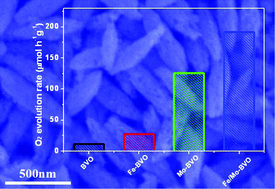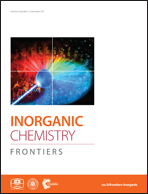Band-gap engineering of porous BiVO4 nanoshuttles by Fe and Mo co-doping for efficient photocatalytic water oxidation†
Abstract
Co-doping of metal ions in semiconductor photocatalysts is a promising strategy to promote photocatalytic activity due to its expected synergistic effects. In this study, we demonstrated the first synthesis of uniform Fe and Mo co-doped BiVO4 (Fe/Mo-BVO) porous nanoshuttles (PNSs) through a simple solvothermal method combined with a subsequent impregnation thermal treatment. It has been discovered that the incorporation of Fe and Mo into the BVO lattice not only influences the shuttle-like morphology and porous structure but also modifies the band structure of the pristine BVO; this consequently boosts the photocatalytic performance of BVO. The as-prepared Fe/Mo-BVO PNSs exhibit significantly enhanced photoactivity for water oxidation under visible-light irradiation, and an average O2 evolution rate of up to 191.5 μmol h−1 g−1 is obtained, which is nearly 1.5 and 17 times higher than the rates obtained for Mo-doped BVO and pristine BVO, respectively. Density functional theory (DFT) calculations were also employed to further investigate the electronic structure of the co-doped products.



 Please wait while we load your content...
Please wait while we load your content...